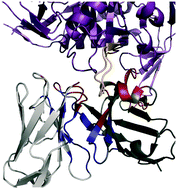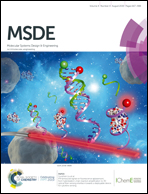Role of antibody heavy and light chain interface residues in affinity maturation of binding to HIV envelope glycoprotein†
Abstract
The FV region of an antibody consists of the heavy chain (HC) and light chain (LC) variable domains whose association is maintained by a series of conserved, non-polar interactions. During chronic infections, somatic mutations are induced, often in the HC/LC interface. Sequence variation in these interactions allows the HC and LC domains to inhabit a range of orientations relative to one another. Thus, we hypothesize that these interface mutations are critical to orient and rigidify the HC/LC interface to arrange the paratope for optimal interaction with the antigen, thereby affecting antigen binding affinity allosterically. To test this hypothesis, we measured the HC/LC orientation of a set of broad and potent human HIV neutralizing antibodies. The HC/LC interface of these antibodies contained a large number of mutations and achieved unusual relative orientations compared to other human antibodies. We expressed and characterized a panel of recombinant HIV CD4 binding site antibodies as the fully matured variant and compared these with variants mutated to the HC/LC interface of the inferred unmutated common ancestor antibody. We found that HC/LC interface reverted antibodies have a reduced affinity, confirming that introduction of somatic mutations in the HC/LC interface was one of the critical steps in affinity maturation. We then used the Rosetta software suite to examine the mechanisms through which these mutations affect binding affinity. We determined to what extent the mutations were critical in altering the relative orientation of HC/LC domains to a conformation that is competent to bind the antigen. We further determined whether the mutations excluded alternative HC/LC conformations that would be incompetent to bind the antigen. These findings suggest that somatic mutations in the HC/LC interface, distant from the antigen/antibody contact region, play a critical role in affinity maturation of HIV antibodies by preconfiguring the bound conformation of the antibody in the orientation required for high affinity recognition of the antigen. Thus, optimization of HC/LC interface could serve as an important tool for maximizing antibody/antigen binding affinity without altering antigen contact residues.

- This article is part of the themed collection: Engineering immunity with quantitative tools


 Please wait while we load your content...
Please wait while we load your content...